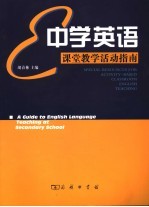

中学英语课堂教学活动指南PDF电子书下载
- 电子书积分:9 积分如何计算积分?
- 作 者:胡春林主编;周文兰,焦晓骏,陆绍寅,宗凤昌编
- 出 版 社:北京:商务印书馆
- 出版年份:2006
- ISBN:7100049156
- 页数:160 页
Part One English Teaching Planning 2
Ⅰ.What is a lesson plan? 2
Ⅱ.What should go into an English language lesson? 2
Ⅲ.Why is planning important? 3
Ⅳ.How should we plan a lesson? 3
Ⅴ.Micro-teaching lesson 6
Ⅵ.Tips for classroom teachers 7
Ⅶ.Sample lesson plan 9
Part Two Activity-based Teaching Methods 15
Section 1 Guidance to Listening and Speaking 15
Ⅰ.Listening development 15
(Ⅰ)Students'problems in listening 15
(Ⅱ)Suggestions for the development of listening 16
Ⅱ.Speaking development 19
(Ⅰ)Students'problems in speaking 19
(Ⅱ)Ways to deal with the problems 19
(Ⅲ)Suggestions for the development of speaking 22
Ⅲ.Sample lesson plan 23
Ⅳ.Suggested listening and speaking activities 27
(Ⅰ)Cuisenaire rods 27
(Ⅱ)Circle games 28
(Ⅲ)Picture consequences 33
(Ⅳ)Word guessing games 34
(Ⅴ)Role play 37
(Ⅵ)True/False stories 41
(Ⅶ)Picture talking or description 42
(Ⅷ)"For or Against"debates 45
Ⅴ.Other effective speaking and talking activities 45
(Ⅰ)Bribery 45
(Ⅱ)Hangman 46
(Ⅲ)Time out 46
(Ⅳ)The untrophy 46
(Ⅴ)The last word 47
(Ⅵ)Doctors and patients 47
(Ⅶ)Jigsaw puzzle challenge 47
(Ⅷ)Something in common or"give me five" 48
(Ⅸ)Create a biography 48
(Ⅹ)Top five lists 49
(Ⅺ)Mini-talks 50
(Ⅻ)Erase the dialogue 50
(ⅩⅢ)Motivating speaking activities 51
(ⅩⅣ)Chain story telling activity 52
(ⅩⅤ)Improving discussion lessons 53
Section 2 Guidance to Reading 54
Ⅰ.Guided reading 54
Ⅱ.Reading comprehension 57
(Ⅰ)The purpose of reading 57
(Ⅱ)How to improve reading comprehension? 58
(Ⅲ)Reading approaches 59
(Ⅳ)Sample lesson plans 67
Ⅲ.Suggested reading activities 78
(Ⅰ)Newspaper reading activities 78
(Ⅱ)Text quickies 81
(Ⅲ) Reading aloud 82
(Ⅳ)The spending maze 83
(Ⅴ)Jigsaw reading 84
(Ⅵ)Working with classroom readers 85
(Ⅶ)Activities to do with texts 86
Section 3 Guidance to Writing 87
Ⅰ.Provide many opportunities for students to write daily 87
Ⅱ.An idealised procedure for teaching writing 88
Ⅲ.Give students guidance and explicit instruction that develop effective writing skills and strategies 90
(Ⅰ)Model writing process 90
(Ⅱ)Guide writing strategies 91
Ⅳ.Suggested writing activities 104
(Ⅰ)Block buster 104
(Ⅱ)Dangerous road 105
(Ⅲ)Writing an essay on cause and effect 107
(Ⅳ)Lexical threads 109
(Ⅴ)Role-play writing 110
Ⅴ.Other effective writing activities 113
(Ⅰ)Story starters 113
(Ⅱ)Collaborative/Co-authored writing 113
(Ⅲ)Writing/Writers'circles 113
(Ⅳ)Writer's notebook 113
(Ⅴ)Interactive writing 114
(Ⅵ)Writing workshops 114
(Ⅶ)Writing through"reverse reading" 115
(Ⅷ)Postcards 116
(Ⅸ)Writing conferences 117
(Ⅹ)Sentence frames 118
(Ⅺ)Improving paragraph writing 118
(Ⅻ)Songs and storytelling 119
(ⅩⅢ)Freeze the writing 119
(ⅩⅣ)Organise argument essays 120
(ⅩⅤ)Writing organizers and maps 121
(ⅩⅥ)Note writing 122
(ⅩⅦ)A dark and stormy night—A creative writing activity 123
(ⅩⅧ)Inquiry and research writing 124
Part Three Related Teaching Methodologies 127
Ⅰ.Task-based Language Teaching(TBLT) 127
(Ⅰ)What is a task? 129
(Ⅱ)What are the reasons for TBLT? 130
(Ⅲ)What are the differences between TBLT and the traditional teaching method? 131
(Ⅳ)How do teachers design tasks? 132
(Ⅴ)What are the stages of TBLT? 133
(Ⅵ)How do teachers plan tasks for a lesson? 135
(Ⅶ)What are the misconceptions in TBLT? 135
(Ⅷ)Sample lesson plan 136
Ⅱ.Student-centred Learning(SCL) 138
(Ⅰ)The definition of student-centred learning 138
(Ⅱ)The features of student-centred learning 139
(Ⅲ)Teacher skills needed in student-centred approaches 140
(Ⅳ)The shift from teacher-centred to student-centred learning 141
(Ⅴ)Creative student-ccntred materials 143
(Ⅵ)Sample lesson plan 144
Ⅲ.Action Research(AR)Overview 148
(Ⅰ)What is Action Research? 148
(Ⅱ)Why should teachers do Action Research? 148
(Ⅲ)What are the steps in the Action Research process? 149
(Ⅳ)Where can your research question(s)come from? 149
(Ⅴ)What evidence can you collect to see whether your solution has worked? 150
(Ⅵ)Guidelines for planning action research projects 151
(Ⅶ)Sample teaching plan 154
Ⅳ.The Reflective Approach(RA) 155
(Ⅰ)Why is RA important? 155
(Ⅱ)What is the beginning of the process of reflection? 156
(Ⅲ)What to do next? 157
(Ⅳ)How to become a reflective teacher? 158
(Ⅴ)Sample teaching plan 158
(Ⅵ)How is RA different from AR? 160
- 《高级英语阅读与听说教程》刘秀梅编著 2019
- 《思维导图 超好用英语单词书》(中国)王若琳 2019
- 《培智学校义务教育实验教科书教师教学用书 生活适应 二年级 上》人民教育出版社,课程教材研究所,特殊教育课程教材研究中心编著 2019
- 《花时间 我的第一堂花艺课 插花基础技法篇》(日)花时间编辑部编;陈洁责编;冯莹莹译 2020
- 《课堂上听不到的历史传奇 世界政治军事名人 初中版》顾跃忠等编著 2015
- 《初中生英语作文 提高篇》清瑶主编 2019
- 《指向核心素养 北京十一学校名师教学设计 英语 七年级 上 配人教版》周志英总主编 2019
- 《培生高级英语语法 练习册》培生教育 2019
- 《365奇趣英语乐园 世界民间故事》爱思得图书国际企业 2018
- 《新课标背景下英语教学理论与教学活动研究》应丽君 2018
- 《指向核心素养 北京十一学校名师教学设计 英语 七年级 上 配人教版》周志英总主编 2019
- 《北京生态环境保护》《北京环境保护丛书》编委会编著 2018
- 《商务英语口译教程 第3版》朱佩芬,徐东风编著 2017
- 《指向核心素养 北京十一学校名师教学设计 英语 九年级 上 配人教版》周志英总主编 2019
- 《实用商务英语听说 第1册》窦琳,江怡平主编 2019
- 《英语实训教程 第2册 商务英语听说》盛湘君总主编 2019
- 《高等院校旅游专业系列教材 旅游企业岗位培训系列教材 新编北京导游英语》杨昆,鄢莉,谭明华 2019
- 《近代民营出版机构的英语函授教育 以“商务、中华、开明”函授学校为个案 1915年-1946年版》丁伟 2017
- 《手工皮艺 时尚商务皮革制品制作详解》王雅倩责任编辑;陈涤译;(日)高桥创新出版工坊 2019
- 《指向核心素养 北京十一学校名师教学设计 数学 九年级 上 配人教版》周志英总主编 2019
